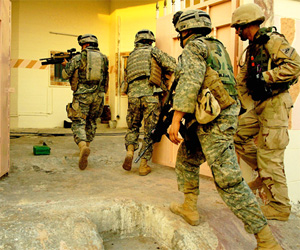![]()
FROM JOSEPH FARAH'S G2 BULLETIN
Rules of engagement killing U.S. soldiers
You won't believe how politics handcuff troops in Afghanistan
F. Michael
Maloof
© 2009 WorldNetDaily
 WASHINGTON –
New military rules of engagement ostensibly to protect Afghan civilians are
putting the lives of U.S. forces in jeopardy, claim Army and Marine sources,
as the Taliban learns to game plan based the rules' imposed limits.
WASHINGTON –
New military rules of engagement ostensibly to protect Afghan civilians are
putting the lives of U.S. forces in jeopardy, claim Army and Marine sources,
as the Taliban learns to game plan based the rules' imposed limits.
The rules of engagement, or ROEs, apply to all coalition forces of the United States and the North Atlantic Treaty Organization. Their enactment is in response to Afghan President Hamid Karzai's complaints over mounting civilian deaths apparently occurring in firefights.
Despite the fact that the newly arrived U.S. commander in Afghanistan, General Stanley McChrystal, imposed the more restrictive ROEs to minimize the killing of innocent civilians, however, the Taliban is well aware of them and has its own forces acting in ways to counteract them.
The impact of new restrictions has created increasing frustration and concern among U.S. Army and Marine Corps troops who now are compelled to follow these rules despite the danger of letting the Taliban live to fight again another day.
Critics see the new ROEs being more oriented toward defensive rather than offensive operations, as evidenced by recent charges of murder against two U.S. Army snipers because they had targeted a Taliban commander who reportedly wasn't holding a weapon.
The actual ROEs are said to be classified U.S. and NATO secrets, but based on individual soldier accounts, those restrictions include the following:
- No night or surprise searches
- Villagers are to be warned prior to searches
- Afghan National Army, or ANA, or Afghan National Police, or ANP, must
accompany U.S. units on searches
- U.S. soldiers may not fire at insurgents unless they are preparing to
fire first
- U.S. forces cannot engage insurgents if civilians are present
- Only women can search women
- Troops can fire on insurgents if they catch them placing an IED but not if insurgents walk away from where the explosives are.
Often, rules of engagement require varying levels of approvals before action can be taken. In one case, villagers had tipped off U.S. forces of the presence of a Taliban commander who was threatening village elders.
To get permission to go after him, U.S. troops had to get 11 separate Afghan, U.S. and international forces' approval to the plan. The approval, however, did not come until well into the next day. By then, the Taliban commander had moved on, to the consternation of the villagers who had provided the tip. Observers have claimed that it can take some 96 hours to acquire all the permissions to act.
In other cases, the use of force against insurgents may be blocked if they lower their guns, only to have those insurgents return later to attack.
Also, ISAF troops cannot engage insurgents if they are leaving an area where an IED has been planted. In one case, insurgents planting an IED had detected the presence of U.S. forces and immediately began leaving the area, tossing evidence of their preparations along the way. U.S. forces could not fire on them.
The ROEs in some cases have gone beyond limiting ISAF troops in their operations. In one case, ROE restrictions were in effect when four U.S. Marines twice pleaded by radio for artillery support in combat action in Kunar Province in Afghanistan – and twice they were refused, before they were killed.
F. Michael Maloof, a frequent G2B contributor, is a former senior security policy analyst in the Office of the Secretary of Defense. He can be contacted at mmaloof@wnd.com.
To get access to the full report, subscribe to Joseph Farah's G2 Bulletin.